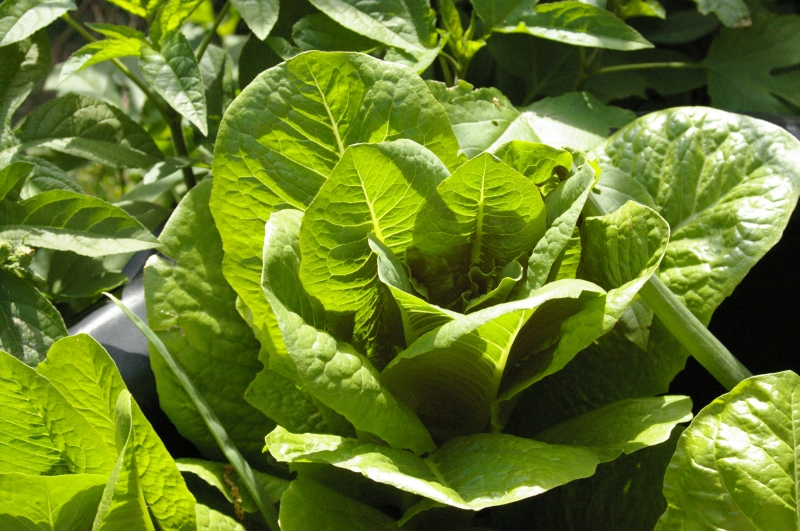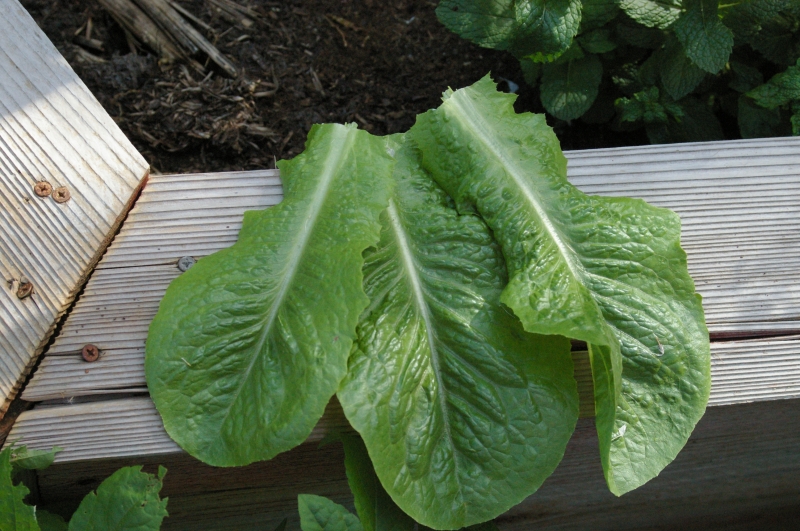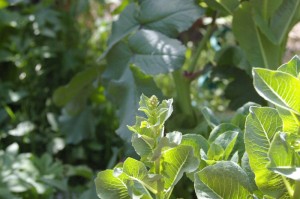Right now my lettuce is at a turning point.
This one is beginning to produce seed. The one below is ready to eat.

If I remove all the mature leaves, it will grow more, and the pruning will prevent it from going to seed at least until it gets a little bit warmer.

Harvesting the whole plant makes no sense when you can get this sort of lettuce of a single plant once a week for months.

Eventually it will all go to seed. I will miss the salads, but it is nice having the seed to plant this year after year.

These lovely plants have been giving us lettuce for five months now. Soon however it will get to warm, and they will bolt despite my best efforts to keep them producing.
Bob

 A page Dedicated to My Writing
A page Dedicated to My Writing
ahhh yes..the dreaded bolting of lettuce.
I would feel badly except that it’s been snowing for the past 16 hours here in Toronto!
….sweet green…soon enough.
We had frost this morning. No really. We also saw snow this winter. That only happens every ten years or so. Here in the subtropical zones of Texas, lettuce is a winter crop.
Bob
We almost had a frost here south of Houston this morning but not quite. It was the same on the snow day here too…. some flakes in the air but none sticking on the ground.
Bob, your lettuce looks better than any I have seen in stores. For the last 3 years I have been losing a little fat by eating a lot more salads and very little (very well done) red meat. Most of my salad is composed of lettuce as fresh as I can get it, with tomatos and carrots, but no dressing. Lots of fruit too. I probably eat lettuce at least once per day now, and sometimes twice. I’m not sure I could eat as many salads as I do without some good lettuce as the main component. It’s changed my whole life…
Skip
I can practically live on salad. I love the stuff. The salad bowl that most families mix the salad in, is what I consider a serving. The best part is that that salad is entirely pesticide free. Usually I don’t have to lift a finger to keep my lettuce perfect and intact. I do have to be a bit careful when I harvest it. One of the reasons I have to be careful is the fire ants. The other reason is the wasps.
Years ago, I was using a circular saw to cut off then end of an overhead board that was part of my workshops upper loft. My workshop is mostly open air so that I catch the breezes in the summer. Anyway, I was almost through the board when I looked and saw about eight inches from my hand was a rather huge wasp nest filled with wasps that were quite alarmed at what I was doing. I stopped sawing. They quickly calmed down and went about their business.
I changed my project and I built a wasp house for them to hang under a tree. That evening I moved the nest. Wasps that peaceful were just what I wanted to encourage. I am going to have wasps in my yard no matter what I do, so I want to give the advantage to peaceful wasps. Since then, from that start, I have ruthlessly selected for a better breed of wasp. Mean, threatening or violent wasps get their entire nest hunted down and destroyed at night. Weak nests that do not flourish also get culled. These wasps are very serious about hunting on my greens and lettuce. The wasps leave me alone, but I would hate to accidentally grab one and put that to the extreme test.
Bob
Mercy! I had no idea that some wasps could be less violent than others. I can say I can pretty well walk through a field of plants without disturbing either wasps or bees; but a nest is a whole ‘nuther problem. We have a site we are working right now in order to get it done before the wasps start making nests all over it.
I do understand what you mean about the wasps cleaning the plants, I just had not thought about how you could control them onto the site of your garden, wasps just come and go don’t you know?
Congrats! Excellent outcome…
Skip
Wasps can learn, but instinct and habit are their dominant guidelines. They come up with different niches, but they do not tolerate other wasps. It is generally unproductive for a wasp to attack mammals and in the case of humans, can seriously reduce their chances of survival. One of them poisons us with intent to kill, and we tend to poison them, their children and brethren and any other insect that are in the area.
When a wasp or bee strays into out house, their behavior dictates my response. If they are peaceful, I will make them a bit of sugar water and lure them outside. If they are not peaceful, then they do not fare as well. It seems like some wasps have remembered my kindness. I cannot prove it though. When a wasp is doing what I want it to do, I remember what it looks like. When a wasp acts in a threatening manner, first I back up and watch to see where it goes. It’s behavior after I know where it’s home is, is directly related to it’s survival. If it continues being threatening, then I become quite active about eliminating that breed. By reducing the numbers of wasps with poor traits, I improve the survival chances of wasps with good traits.
As far as directing them onto plants, I have little to do with that apart from being a bit more tolerant of threatening behavior. As the years have progressed, it seems that the general populace of wasps has become quite a bit more gentle in my yard, so I don’t have to be as active as I once was. Wasps are going to be present no matter what I do, so adjusting their behavior is the best way to make my yard safe for visitors.
My suspicions is that by killing all wasps that we see, we actually reduce the protective layer of wasps that have adapted to getting along with people and leave open niches for the wilder ones to enter our yards.
Bob
Bob said:
“By reducing the numbers of wasps with poor traits, I improve the survival chances of wasps with good traits.”
Once I accept that some wasps have poor traits and others better traits; then I can understand what you’re saying. You put an extraordinary effort into study of individuals I must say, and then apply that “determination” to their entire nest. It’s kind of like the difference in handtooling vs powertooling; you believe the benefit is worth the amount of effort required to accomplish your purpose. I’m not sure I have that level of stick-with-it myself to follow all the way thru.
“As far as directing them onto plants, I have little to do with that apart from being a bit more tolerant of threatening behavior. As the years have progressed, it seems that the general populace of wasps has become quite a bit more gentle in my yard, so I don’t have to be as active as I once was. Wasps are going to be present no matter what I do, so adjusting their behavior is the best way to make my yard safe for visitors.”
Well done! My compliments! I do understand them “grazing” the little critters off of plant leaves and keeping other wasps out. I do not shoo wasps or bees – even if they land on me – unless they are actively attacking me at the time, and I can tell the difference. But I stay away from nests, just in case. Of course, my wife has me kill all nests on general principles when found.
“My suspicions is that by killing all wasps that we see, we actually reduce the protective layer of wasps that have adapted to getting along with people and leave open niches for the wilder ones to enter our yards…. Bob”
Interesting, I do a similar process with ants. Since other species of ant will attack and battle fire ants; I will Amdrol any fire ants and leave the others as a natural barrier. Like the wasps though, if my wife will be working in that part of the yard, she will have me kill all of the ants beforehand.
And I thought we were talking about salads….. silly me….
Skip